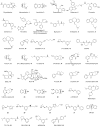Recent developments in novel antidepressants targeting α4β2-nicotinic acetylcholine receptors
- PMID: 24901260
- PMCID: PMC4207546
- DOI: 10.1021/jm401937a
Recent developments in novel antidepressants targeting α4β2-nicotinic acetylcholine receptors
Abstract
Nicotinic acetylcholine receptors (nAChRs) have been investigated for developing drugs that can potentially treat various central nervous system disorders. Considerable evidence supports the hypothesis that modulation of the cholinergic system through activation and/or desensitization/inactivation of nAChR holds promise for the development of new antidepressants. The introductory portion of this Miniperspective discusses the basic pharmacology that underpins the involvement of α4β2-nAChRs in depression, along with the structural features that are essential to ligand recognition by the α4β2-nAChRs. The remainder of this Miniperspective analyzes reported nicotinic ligands in terms of drug design considerations and their potency and selectivity, with a particular focus on compounds exhibiting antidepressant-like effects in preclinical or clinical studies. This Miniperspective aims to provide an in-depth analysis of the potential for using nicotinic ligands in the treatment of depression, which may hold some promise in addressing an unmet clinical need by providing relief from depressive symptoms in refractory patients.
Figures








Similar articles
-
The nicotinic acetylcholine receptor as a target for antidepressant drug development.ScientificWorldJournal. 2012;2012:104105. doi: 10.1100/2012/104105. Epub 2012 Apr 24. ScientificWorldJournal. 2012. PMID: 22619570 Free PMC article. Review.
-
Selective ligand behaviors provide new insights into agonist activation of nicotinic acetylcholine receptors.ACS Chem Biol. 2014 May 16;9(5):1153-9. doi: 10.1021/cb400937d. Epub 2014 Mar 5. ACS Chem Biol. 2014. PMID: 24564429 Free PMC article.
-
Chemistry and pharmacology of nicotinic ligands based on 6-[5-(azetidin-2-ylmethoxy)pyridin-3-yl]hex-5-yn-1-ol (AMOP-H-OH) for possible use in depression.ChemMedChem. 2009 Aug;4(8):1279-91. doi: 10.1002/cmdc.200900079. ChemMedChem. 2009. PMID: 19569163 Free PMC article.
-
Role of neuronal nicotinic acetylcholine receptors (nAChRs) on learning and memory in zebrafish.Psychopharmacology (Berl). 2014 May;231(9):1975-85. doi: 10.1007/s00213-013-3340-1. Epub 2013 Dec 6. Psychopharmacology (Berl). 2014. PMID: 24311357
-
Nicotinic acetylcholine receptors and depression: a review of the preclinical and clinical literature.Psychopharmacology (Berl). 2010 Sep;212(1):1-12. doi: 10.1007/s00213-010-1932-6. Epub 2010 Jul 8. Psychopharmacology (Berl). 2010. PMID: 20614106 Free PMC article. Review.
Cited by
-
Nicotinic Acetylcholine Receptor Agonists for the Treatment of Alzheimer's Dementia: An Update.Nicotine Tob Res. 2019 Feb 18;21(3):370-376. doi: 10.1093/ntr/nty116. Nicotine Tob Res. 2019. PMID: 30137524 Free PMC article. Review.
-
Moon, Mars and Minds: Evaluating Parkinson's disease mortality among U.S. radiation workers and veterans in the million person study of low-dose effects.Z Med Phys. 2024 Feb;34(1):100-110. doi: 10.1016/j.zemedi.2023.07.002. Epub 2023 Aug 1. Z Med Phys. 2024. PMID: 37537100 Free PMC article.
-
Determinants for α4β2 vs. α3β4 Subtype Selectivity of Pyrrolidine-Based nAChRs Ligands: A Computational Perspective with Focus on Recent cryo-EM Receptor Structures.Molecules. 2021 Jun 12;26(12):3603. doi: 10.3390/molecules26123603. Molecules. 2021. PMID: 34204637 Free PMC article.
-
Ropanicant (SUVN-911), an α4β2 nicotinic acetylcholine receptor antagonist intended for the treatment of depressive disorders: pharmacological, behavioral, and neurochemical characterization.Psychopharmacology (Berl). 2022 Jul;239(7):2215-2232. doi: 10.1007/s00213-022-06108-6. Epub 2022 Mar 17. Psychopharmacology (Berl). 2022. PMID: 35298691
-
Blockade of nicotinic acetylcholine receptor enhances the responsiveness to bupropion in the mouse forced swim test.Behav Brain Res. 2019 Mar 15;360:262-269. doi: 10.1016/j.bbr.2018.12.027. Epub 2018 Dec 12. Behav Brain Res. 2019. PMID: 30552947 Free PMC article.
References
-
- World Health Organization. Mental health and development: targeting people with mental health conditions as a vulnerable group; WHO Press: Geneva, Switzerland, 2010.
-
- Berton O.; Nestler E. J. New approaches to antidepressant drug discovery: beyond monoamines. Nat. Rev. Neurosci. 2006, 7, 137–151. - PubMed
-
- Ruhe H. G.; Huyser J.; Swinkels J. A.; Schene A. H. Switching antidepressants after a first selective serotonin reuptake inhibitor in major depressive disorder: a systematic review. J. Clin. Psychiatry 2006, 67, 1836–1855. - PubMed
-
- Sinyor M.; Schaffer A.; Levitt A. The sequenced treatment alternatives to relieve depression (STAR*D) trial: a review. Can. J. Psychiatry 2010, 55, 126–135. - PubMed
-
- Janowsky D. S.; el-Yousef M. K.; Davis J. M.; Sekerke H. J. A cholinergic–adrenergic hypothesis of mania and depression. Lancet. 1972, 2, 632–635. - PubMed
Publication types
MeSH terms
Substances
Grants and funding
LinkOut - more resources
Full Text Sources
Other Literature Sources
Medical

